
Transportation in Singapore is predominantly land-based, with a comprehensive network of roads making many parts of the city-state, including islands such as Sentosa and Jurong Island, accessible. The road network is complemented by a robust rail system consisting of the Mass Rapid Transit (MRT) and the Light Rail Transit (LRT), which cover the length and width of Singapore and serve a few neighbourhoods respectively. The main island of Singapore is also connected to other islands via ferryboat services. Furthermore, the city-state maintains strong international connections through two bridges linking it to Malaysia – the Causeway and the Second Link – and the Singapore Changi Airport, a major aviation hub in Asia.

Punggol, old name as Ponggol, is a planning area and new town situated on the Tanjong Punggol peninsula in the North-East Region of Singapore. The town directly borders Sengkang to the south and shares riverine boundaries with the planning area of Seletar to the west and Pasir Ris to the east. Bounding the town to the north and north-east is the Straits of Johor, with Coney Island included as a part of the Punggol planning area.

Pasir Ris is a planning area and residential town located in the East Region of Singapore. It is bordered by Tampines and Paya Lebar to the south, Sengkang to the southwest and Changi to the east. The planning area also shares riverine boundary with Punggol to the west, separated by the Serangoon River, as well as having a maritime boundary with the North-Eastern Islands planning area, across the Straits of Johor.
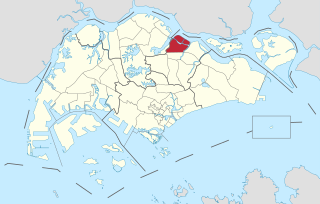
Seletar is an area located in the north-east of Singapore. Its name can also refer to the Seletar Planning Area, situated in the North-East Region of Singapore. The place name was derived from the Malay subgroup who were indigenous to the area, the Orang Seletar. It shares boundaries with the planning areas of Sengkang to the south, Punggol to the east, Yishun and Simpang to the west, as well as the Straits of Johor to the north.
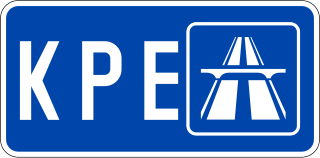
The Kallang–Paya Lebar Expressway (KPE) is the third newest of Singapore's network of expressways. The southern (Kallang) section of the expressway opened first, on 26 October 2007, with the remaining section opened on 20 September 2008.

The Pan Island Expressway is the oldest and longest expressway in Singapore. It is also Singapore's longest road. The expressway runs from the East Coast Parkway near Changi Airport in the east to Tuas in the west and has a total length of 42.8 kilometres (26.6 mi).

The Central Expressway (CTE) in Singapore is the major highway connecting the city centre of Singapore with the northern residential parts of the island, including Toa Payoh, Bishan and Ang Mo Kio and further onwards to the Seletar Expressway and the Tampines Expressway.
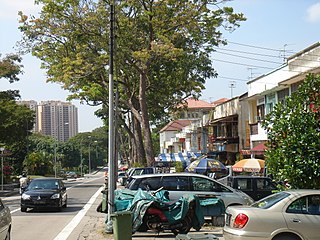
Jalan Kayu is a road situated in Sengkang, Singapore. It is located in the northwestern part of Fernvale, near the Seletar–Sengkang boundary.

The Seletar Expressway is a highway in Singapore that traverses the northern end of the island and joins the Central Expressway (CTE) and the Tampines Expressway (TPE) in Seletar to the Bukit Timah Expressway (BKE) in Kranji.
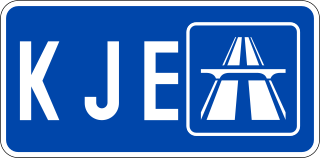
The Kranji Expressway in Singapore connects from the BKE in Bukit Panjang and travels south-west to join with the PIE in Jurong West. Construction of the expressway started in 1990 and was completed in 1994. The expressway is also the second shortest of all the expressways in Singapore at about 8 kilometres (5.0 mi), with the shortest currently being the Marina Coastal Expressway (MCE).

The Bukit Timah Expressway (BKE) is a highway in Singapore that starts at the Pan Island Expressway in Bukit Timah and travels north to the Woodlands Checkpoint and the Johor–Singapore Causeway in Woodlands.
The following lists events that happened during 1996 in Singapore.

Sengkang is a planning area and residential town located in the North-East Region of Singapore. The town is the second most populous in the region, being home to 249,370 residents in 2020. Sengkang shares boundaries with Seletar and Punggol in the north, Pasir Ris and Paya Lebar in the east, Hougang and Serangoon to the south, as well as Yishun and Ang Mo Kio to the west.

The Expressway Monitoring and Advisory System, also known by its acronym of EMAS, is a computerised system that is used to monitor traffic on Singapore's expressways. EMAS enables Land Transport Authority (LTA) personnel to detect accidents and respond to them more quickly. In addition, it notifies motorists of adverse traffic conditions.
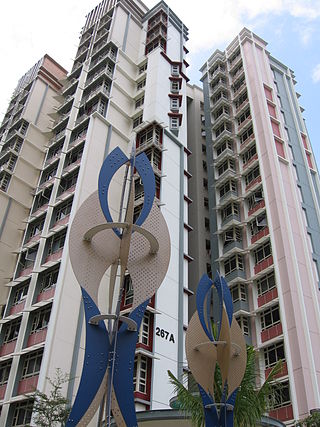
Buangkok is a neighbourhood located in north eastern Singapore. Whilst its boundaries are vague, the neighbourhood is roughly spread across the Trafalgar and Compassvale subzones of the Hougang and Sengkang Planning Areas respectively, as designated by the URA.

The North-East Region of Singapore is one of the five regions in the country. The region is the most densely populated and has the highest population among the five, with Sengkang being its most populous town as of 2020 and Seletar as the regional centre. Comprising 13,810 hectares, it includes seven planning areas and is largely a residential region with 217,120 homes. Housing largely consists of high-density HDB public housing estates, however private housing is also present in the region. As its name implies, it is located in the north-eastern part of Singapore.

Sungei Serangoon is a river in the north-eastern part of Singapore. The 8-kilometre river starts as a canal near Tampines Road, and flows through Hougang, where it is joined by tributary Sungei Pinang just before Sengkang, before flowing towards Lorong Halus, where it is joined by another tributary Sungei Blukar, before emptying into the Serangoon Harbour. The river is also known as the Serangoon Estuary. Since 2011, the river has been converted into a reservoir - Serangoon Reservoir.

The North–South Corridor (NSC), originally conceptualised as the North-South Expressway (NSE), is an under-construction expressway that will be the 11th of Singapore's network of expressways when completed. The North South Corridor will serve increasing traffic along the north-south corridor that is currently served by the Central Expressway (CTE). The 21.5 kilometres (13.4 mi) expressway is expected to cost about S$7.47 billion when fully completed in 2029 as North-South Corridor and will connect the East Coast Parkway (ECP) with the northern parts of Singapore.
Lorong Halus is an area in Pasir Ris surrounding a road of the same name. The road leads to industrial buildings and farms in Pasir Ris Farmway. It starts from the Tampines Expressway (TPE) and ends at a pier. There is a road from Lorong Halus that leads to the Lorong Halus Wetland. The wetland treats the water flowing through it, which was a former landfill.

The Seletar Mall is a suburban shopping mall located in Fernvale, Singapore, next to Fernvale LRT station. Construction of the mall started in late 2012 and it officially opened on 28 November 2014.





















